Disclaimer: As a Chewy and Amazon affiliate, I earn from qualifying purchases. This does not impact our reviews and comparisons.
Cats are carnivores and don’t eat grains.
Grains are high in carbs, which cats have no need for. A grain doesn’t offer any nutritional benefit to cats.
Cats may experience food intolerance to grains. Since they don’t have benefit, some cat owners might opt to choose grain-free cat food.
In this guide, I’ll suggest some of the best grain-free cat foods from the popular options. I’ve opted for choices that are lower in carbs and fillers than competing options.
If you want what’s best, my top pick is below…
In the rest of this article I’ll run through my top picks and a buying guide on choosing high protein cat food.
Then I’ll go through frequently asked questions on this topic.
If you want to find what is absolutely the best for your cat, then read on…
Why trust this article?
As a dietitian, I am experienced in health and nutrition research. I’ve got the tools and know-how to tease apart the science. The foods I’ve recommended are heavily scrutinised down to the ingredient list and where possible, tested.
>> Learn More on our About Page
5 Best Grain-Free Cat Foods
The following choices are from my own product database, where I’ve entered nutrition, ingredient and pricing data.
I’ve excluded any foods with:
- Wheat (including gluten meal)
- Corn (including gluten meal)
- Barley
- Oats
The database also includes results from personal testing with my own cats and kittens. Where possible, I prefer recommending products I’ve personally tested to know what the quality is like.
However, if I notice something that is favourable I’ll suggest that in place (but will let you know that I haven’t tested it).
Best Grain-Free Wet Cat Food
Fussie Cat Premium
Fussie Cat premium is packed with delicious tuna that picky cats will love. It’s low carb and grain-free for easy digestion too.
As a complete meal for adult cats, it’s got the nutrition you need for sole feeding.
The recent price increases are an issue though, and tuna isn’t something you can feed cats all the time due to the mercury content.
Pros
Cons
Fussie Cat Premium Ingredients
Tuna, Water Sufficient For Processing, Salmon, Sunflower Seed Oil, Calcium Carbonate, Locust Bean Gum, Carrageenan, Guar Gum, Choline Chloride, Potassium Chloride, Potassium Carbonate, Taurine, Fructooligosaccharide, Sodium Chloride, Zinc Sulfate, Vitamin E Supplement, Ferrous Sulfate, Thiamine Mononitrate (Source of Vitamin B1), Nicotinic Acid (Source of Vitamin B3), Calcium Pantothenate, Manganese Sulfate, Vitamin A Supplement, Copper Sulfate, Riboflavin Supplement (Source of Vitamin B2), Pyridoxine Hydrochloride (Source of Vitamin B6), Folic Acid, Potassium Iodide, Vitamin K3 Supplement, Biotin, Vitamin B12 Supplement
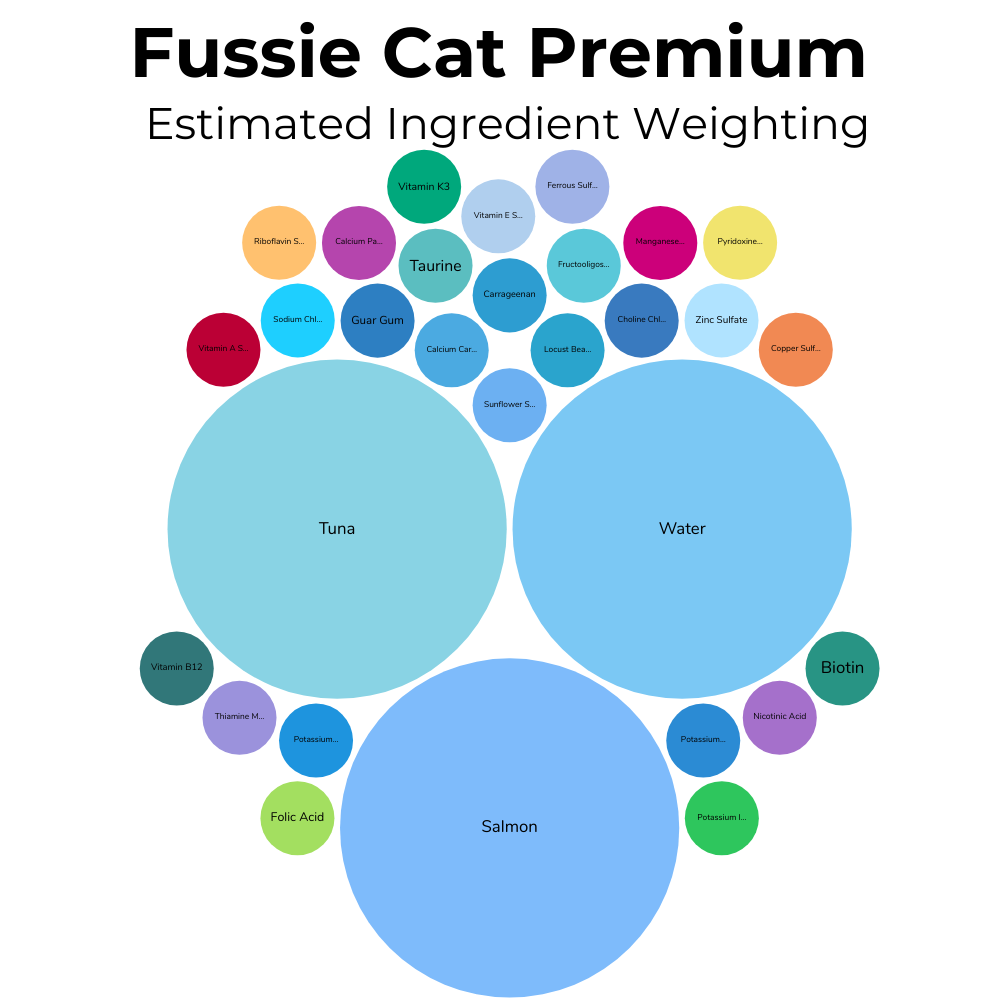
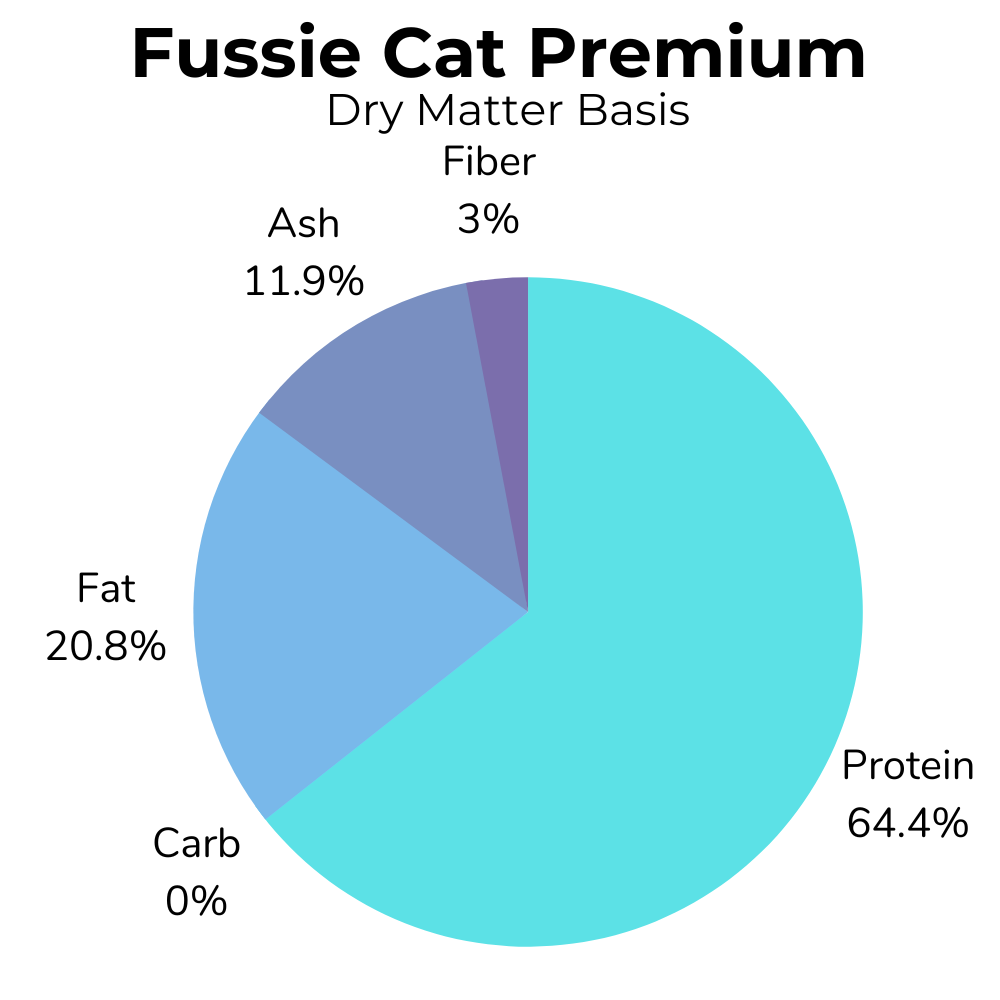
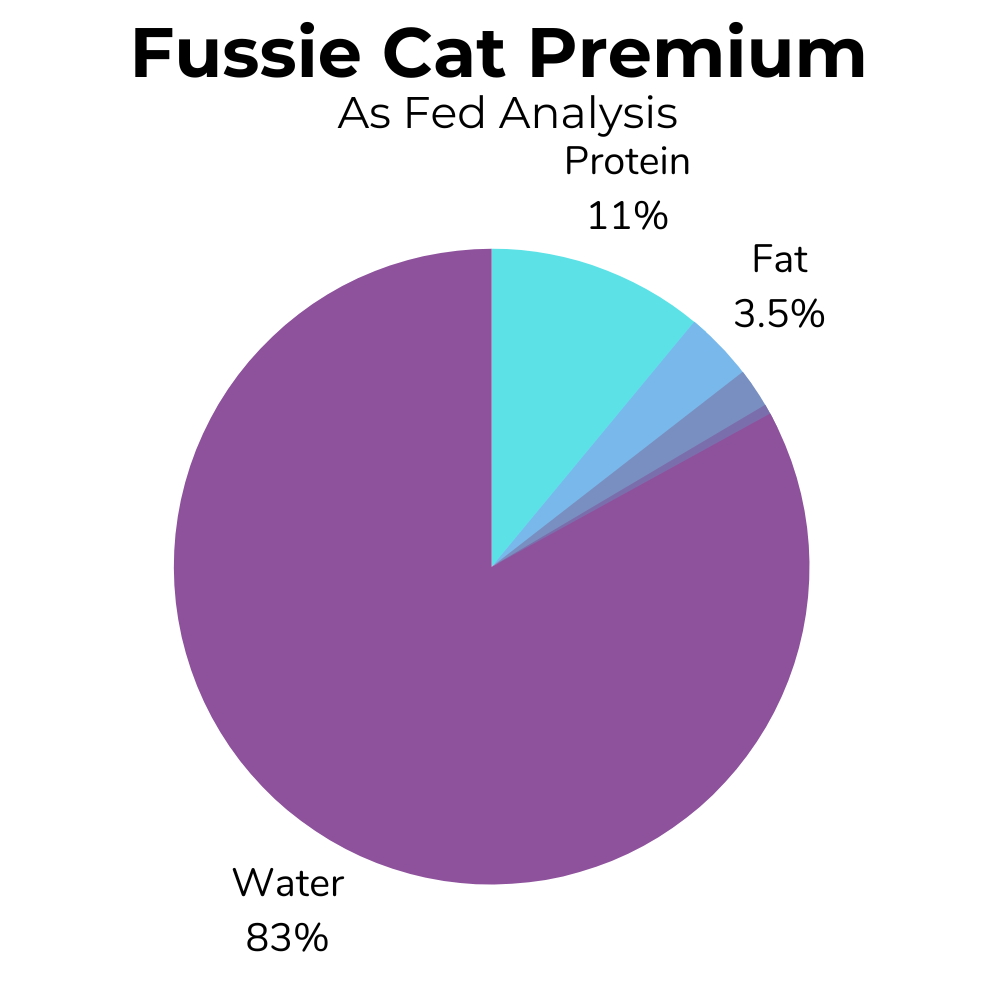
| Key Feature | Note |
|---|---|
| Type | Wet (aspic) |
| Lifestage | Adults |
| Energy (kcal/kg) | 612 |
| Made in | Thailand |
| Cost per ounce* (market ave) | $0.75 ($0.48) |
Best Grain-Free Cat Food for Indoor Cats
Tiki Cat After Dark
Tiki Cat After Dark is totally grain-free and doesn’t have any other carb rich fillers. That makes it super easy to digest for your feline friend.
At 751kg/kcal, this is a lower calorie option which will help indoor cats maintain a healthy weight.
It’s price is the main downside here, but has the quality in the tin.
>> Our review of Tiki Cat After Dark
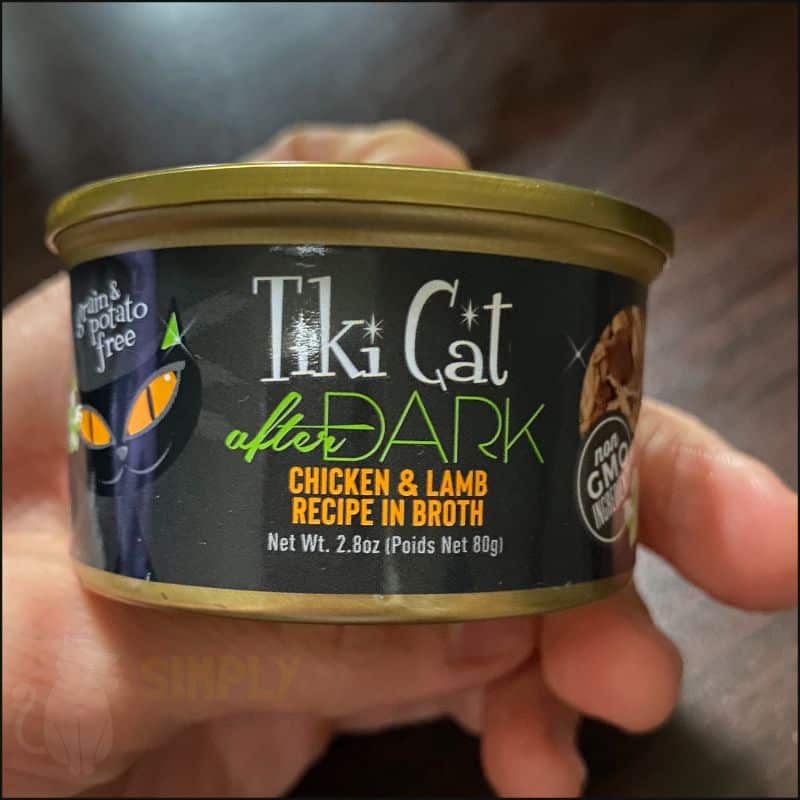
Pros
Cons
Tiki Cat After Dark Ingredients
Chicken, chicken broth, chicken liver, chicken gizzard, chicken heart, tricalcium phosphate, potassium chloride, choline chloride, magnesium sulfate, salt, taurine, ferrous sulfate, thiamine mononitrate (vitamin B1), vitamin E supplement, tuna oil, niacin (vitamin B3), zinc oxide, vitamin A supplement, biotin, vitamin B12 supplement, copper amino acid chelate, manganous oxide, calcium pantothenate, riboflavin supplement (vitamin B2), sodium selenite, pyridoxine hydrochloride (vitamin B6), folic acid, potassium iodide, vitamin D3 supplement
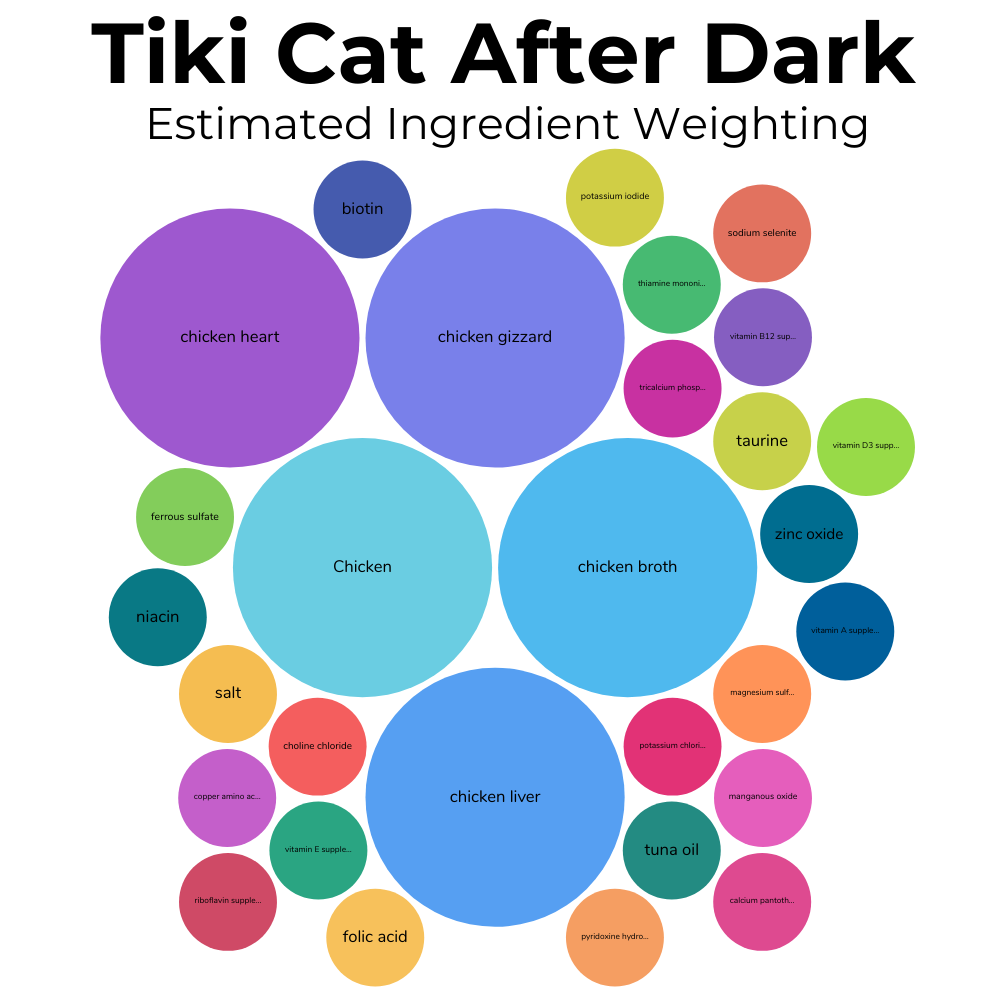
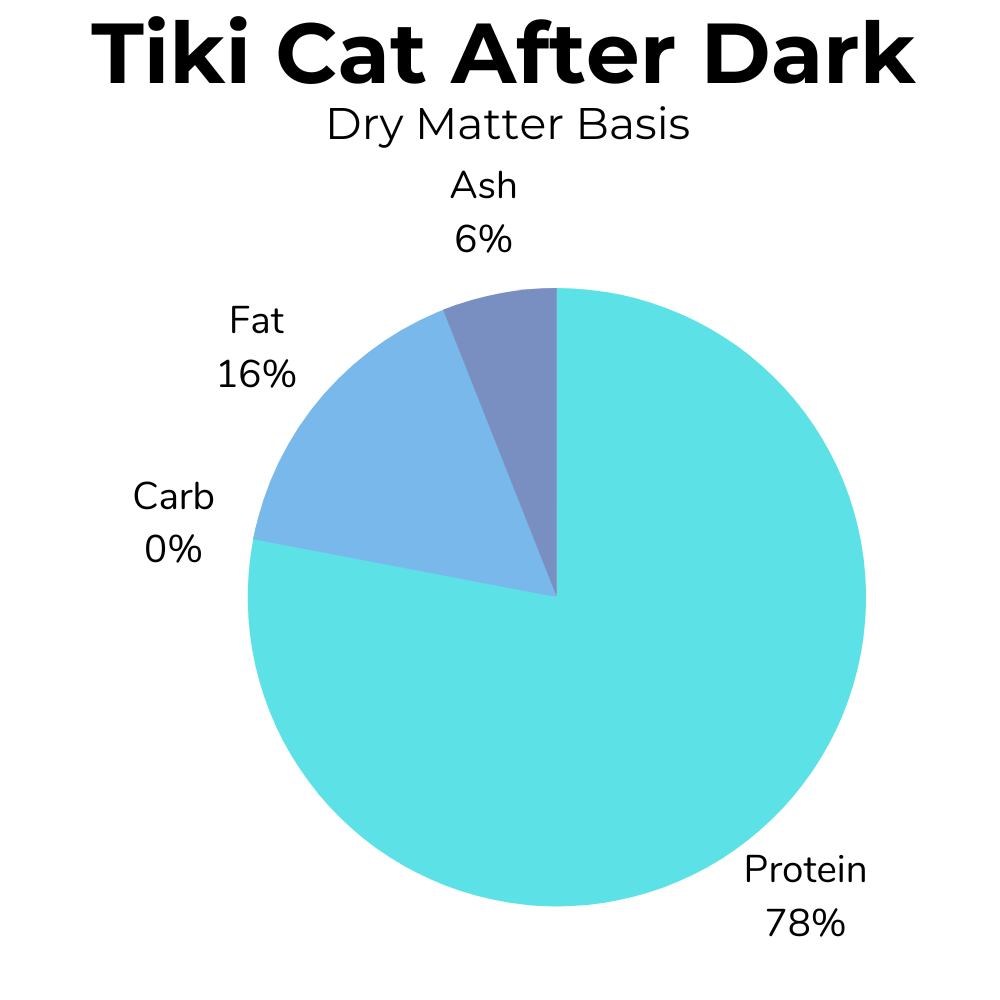

| Key Feature | Note |
|---|---|
| Type | Wet (shreds) |
| Lifestage | All |
| Energy (kcal/kg) | 751 |
| Made in | Thailand |
| Cost per ounce* (market ave) | $0.62 ($0.48) |
Best Grain-Free Dry Cat Food
Dr. Elsey’s Clean Protein
It’s no easy feat finding high protein dry cat food, but Dr. Elsey’s bucks that trend. At over 65% protein, it’s one of the best on the market and has a taste customers love.
The cat food uses gelatin, a high protein ingredient, instead of grains for texture. That means more protein and less carbs – all great things for easy digestion and top health.
We’ve seen some customers report negative quality changes. Since we haven’t tried it, it’s hard to say if they are right.
Pros
Cons
Dr. Elsey’s Clean Protein Ingredients
Chicken, Pork Protein Isolate, Gelatin, Chicken Fat (Preserved With Mixed Tocopherols), Flaxseed, Natural Flavor, Salmon Oil, Potassium Citrate, Calcium Carbonate, Fructooligosaccharide, Calcium Carbonate, Choline Chloride, Vitamins (Vitamin E Supplement, Niacin Supplement, D-Calcium Pantothenate, Vitamin A Acetate, Thiamine Mononitrate, Pyridoxine Hydrochloride, Riboflavin Supplement, Vitamin D3 Supplement, Biotin, Vitamin B12 Supplement, Folic Acid), Minerals (Ferrous Sulfate, Zinc Oxide, Calcium Carbonate, Manganous Oxide, Copper Sulfate, Iron Amino Acid Chelate, Manganese Amino Acid Chelate, Zinc Amino Acid Chelate, Copper Amino Acid Chelate, Sodium Selenite, Cobalt Carbonate, Ethylenediamine Dihydroiodide), Potassium Chloride, Mixed Tocopherols (Preservative), Taurine, Salt, Rosemary Extract
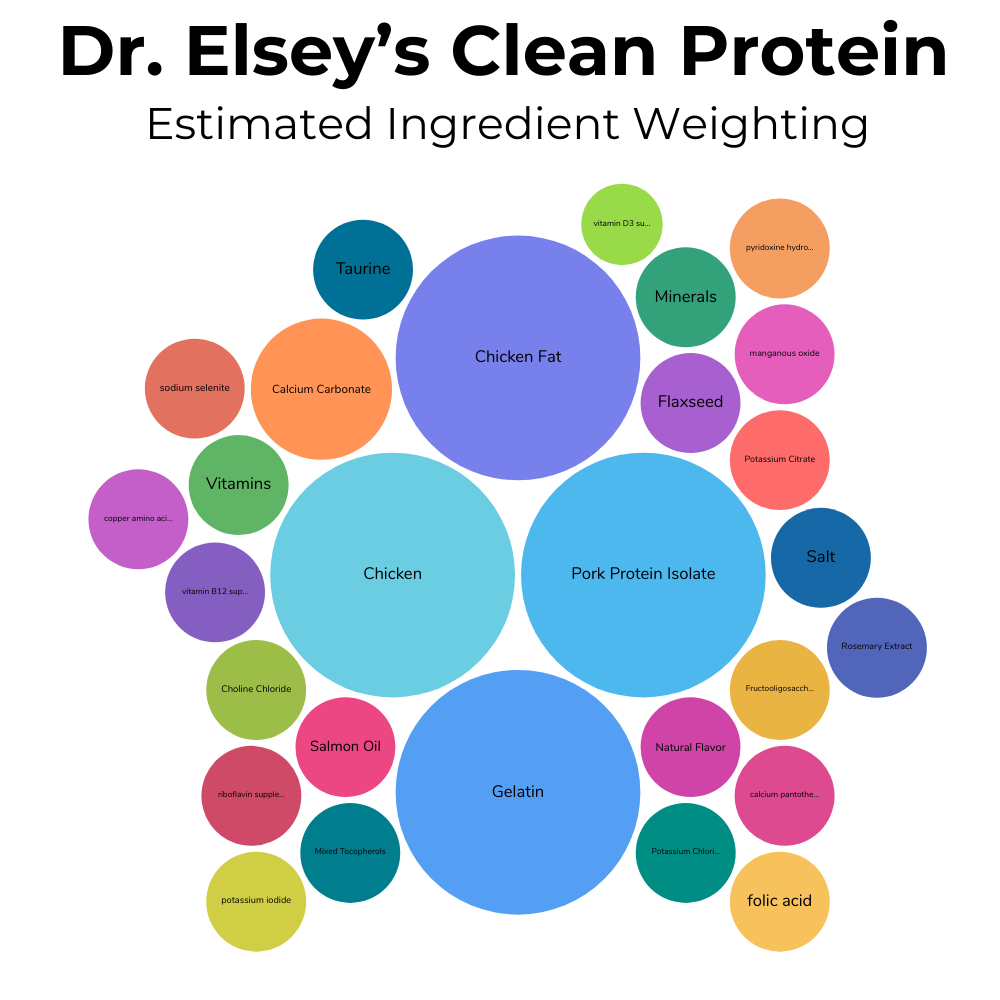
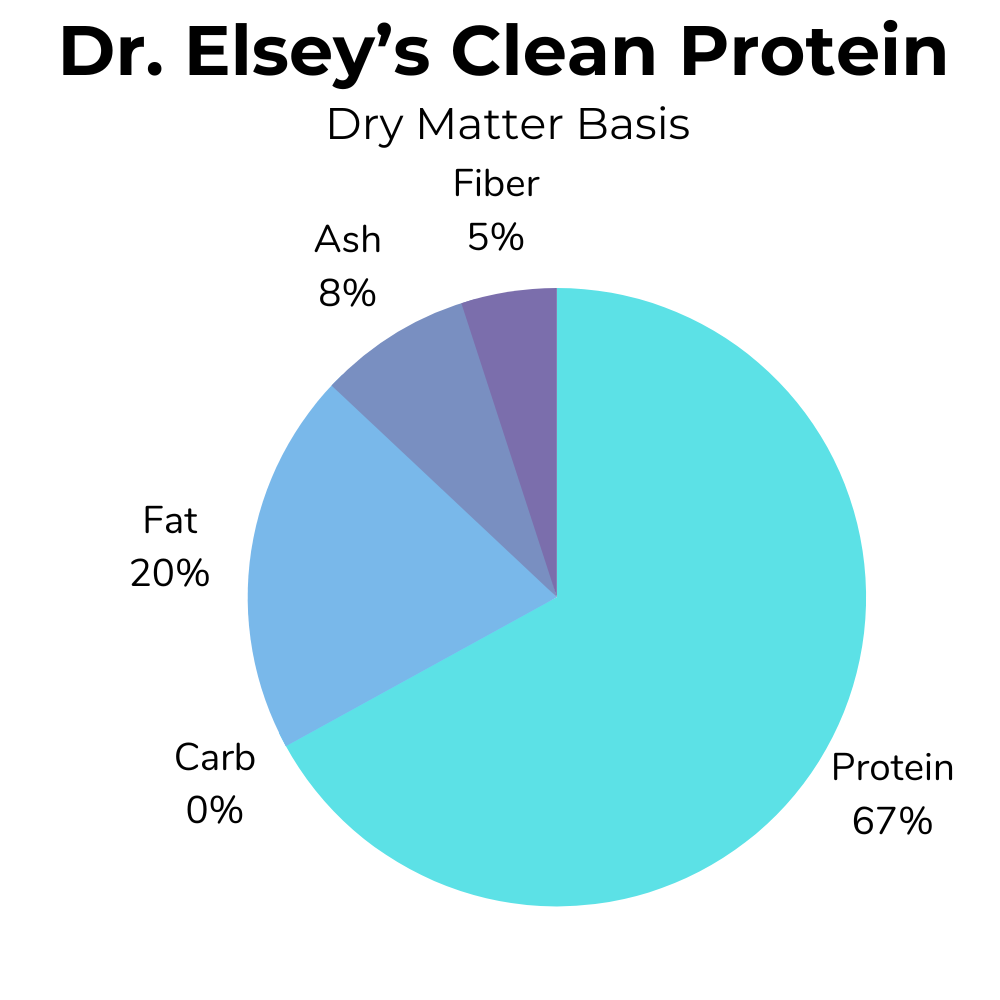
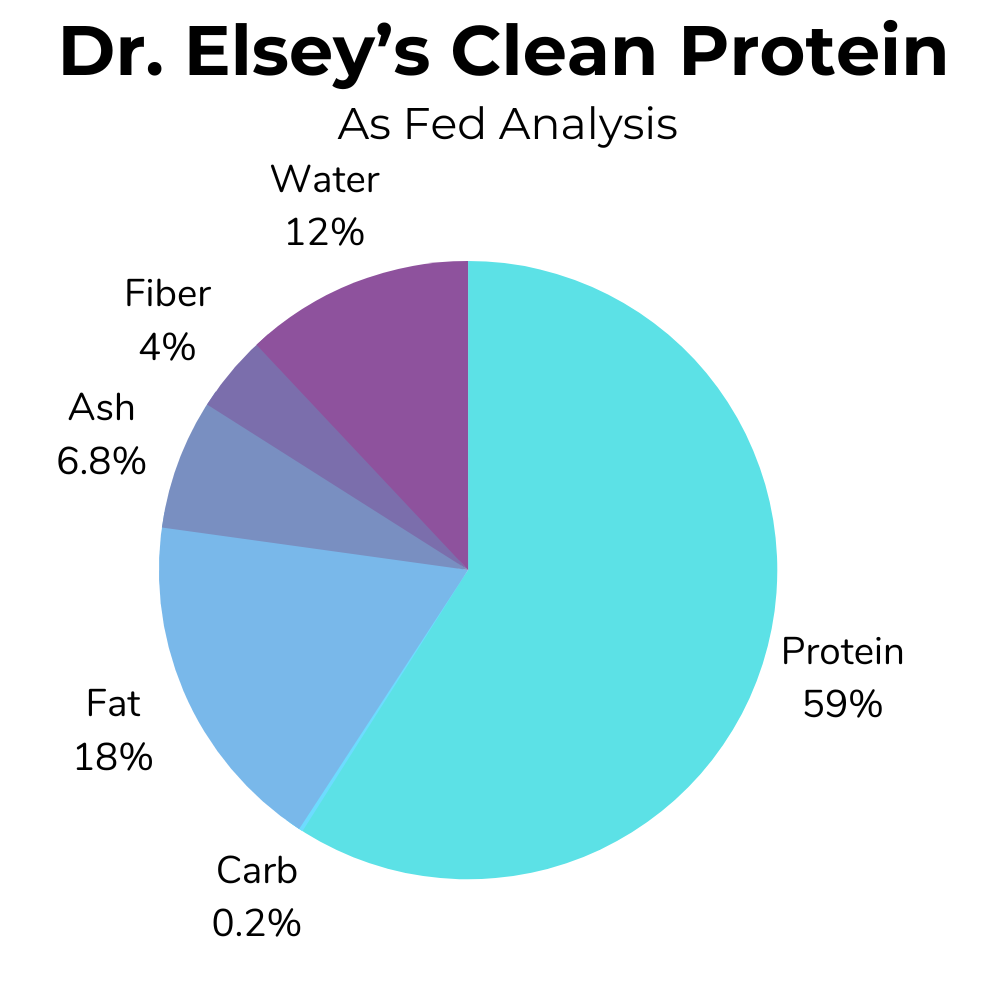
| Key Feature | Note |
|---|---|
| Type | Dry (kibble) |
| Lifestage | All |
| Energy (kcal/kg) | 4,030 |
| Made in | USA |
| Cost per ounce* (market ave) | $0.40 ($0.48) |
Best Grain-Free Kitten Food
Fancy Feast Kitten
Fancy Feast Kitten is chock full of meaty goodness and doesn’t use any grains, potato or corn. Very affordable pick.
Most cats will enjoy this, as do mine. It’s a complete meal for growing kittens, so they’ll get what they need.
My main gripe is the quality which can vary from time to time. Aside from that, this product is good value for money.
>> Our review of Fancy Feast
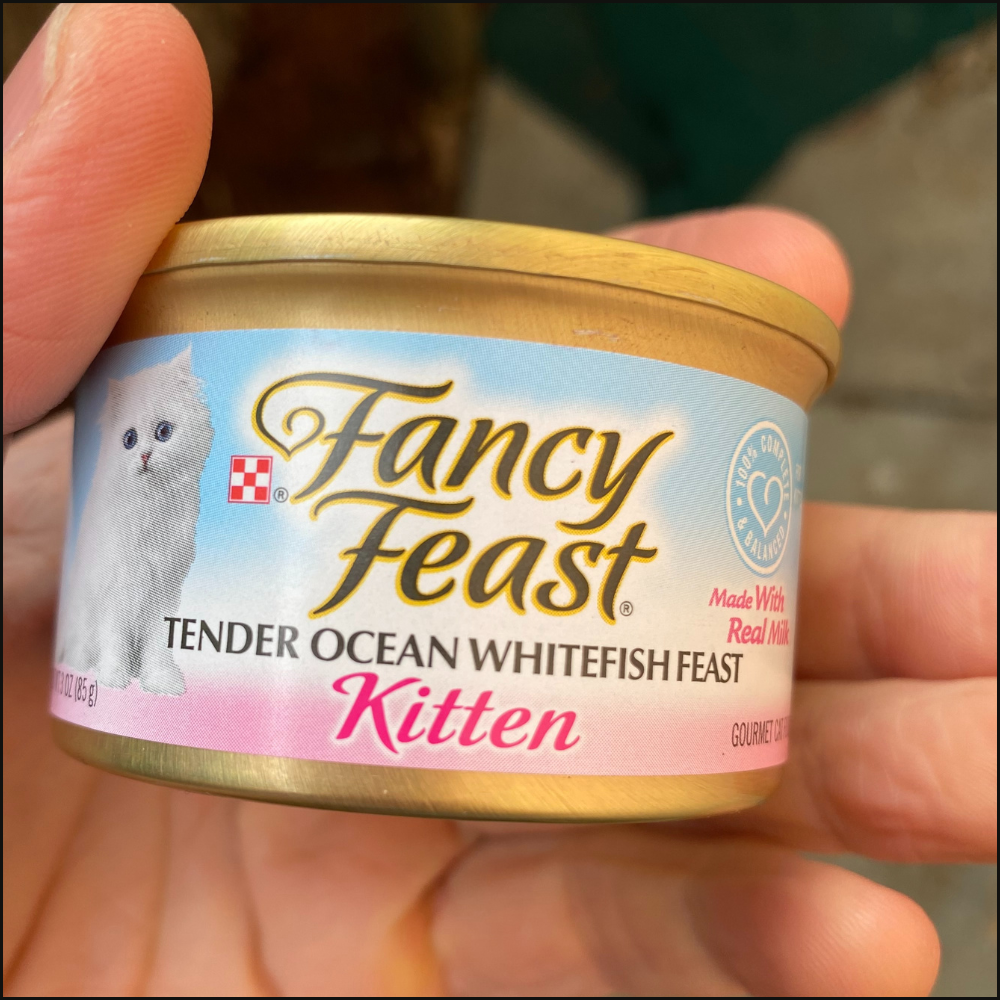
Pros
Cons
Fancy Feast Kitten Ingredients
Ocean Whitefish, Liver, Meat By-Products, Chicken, Fish Broth, Milk, Egg Product, Artificial and Natural Flavors, Tricalcium Phosphate, Added Color, Guar Gum, Minerals [Potassium Chloride, Magnesium Sulfate, Zinc Sulfate, Ferrous Sulfate, Copper Sulfate, Manganese Sulfate, Potassium Iodide], Salt, Vitamins [Vitamin E Supplement, Thiamine Mononitrate (Vitamin B-1), Niacin (Vitamin B-3), Calcium Pantothenate (Vitamin B-5), Vitamin A Supplement, Menadione Sodium Bisulfite Complex (Vitamin K), Pyridoxine Hydrochloride (Vitamin B-6), Riboflavin Supplement (Vitamin B-2), Vitamin B-12 Supplement, Biotin (Vitamin B-7), Folic Acid (Vitamin B-9), Vitamin D-3 Supplement], Taurine
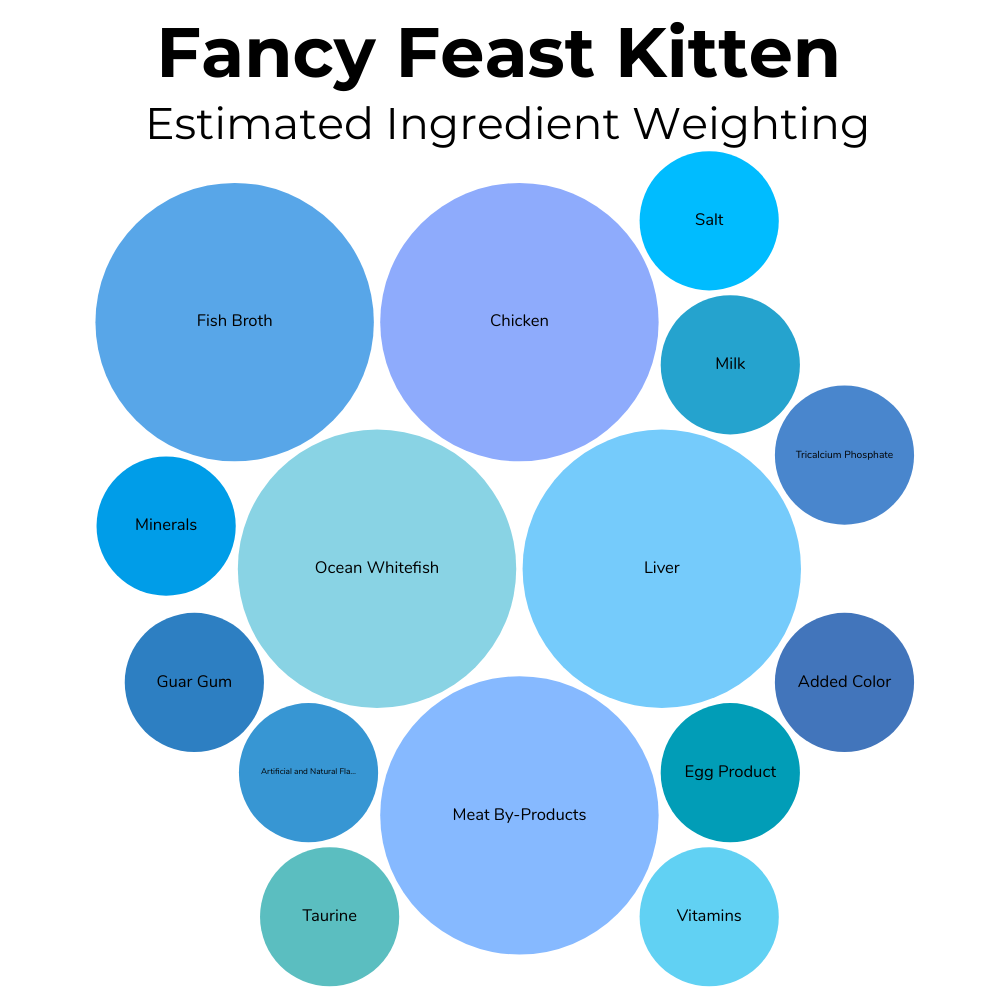
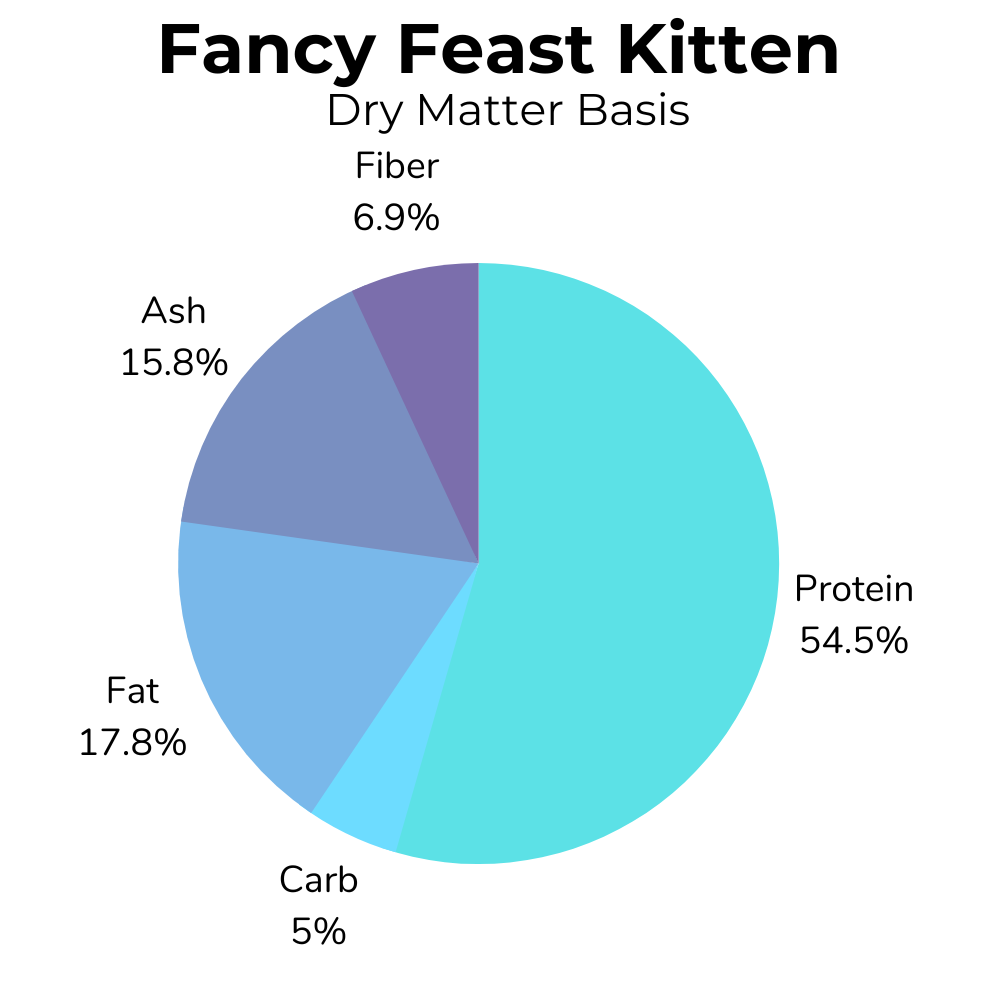

| Key Feature | Note |
|---|---|
| Type | Wet (pate) |
| Lifestage | All |
| Energy (kcal/kg) | 1,064 |
| Made in | USA |
| Cost per ounce* (market ave) | $0.46 ($0.48) |
Best Affordable Grain-Free Cat Food
Taste of the Wild
At around $0.18 per ounce (subject to change), Taste of the Wild is a grain-free delight that’s easier on the budget.
It’s packed with chicken as a main ingredient, to boost protein and power up your finnicky feline. A complete meal for all life stages too.
Our cat tester didn’t enjoy it as much though (despite positive customer reports) on first try. There’s also a lot peas and potato to contend with, which could be lower in the bag.
>> Our review of Taste of the Wild
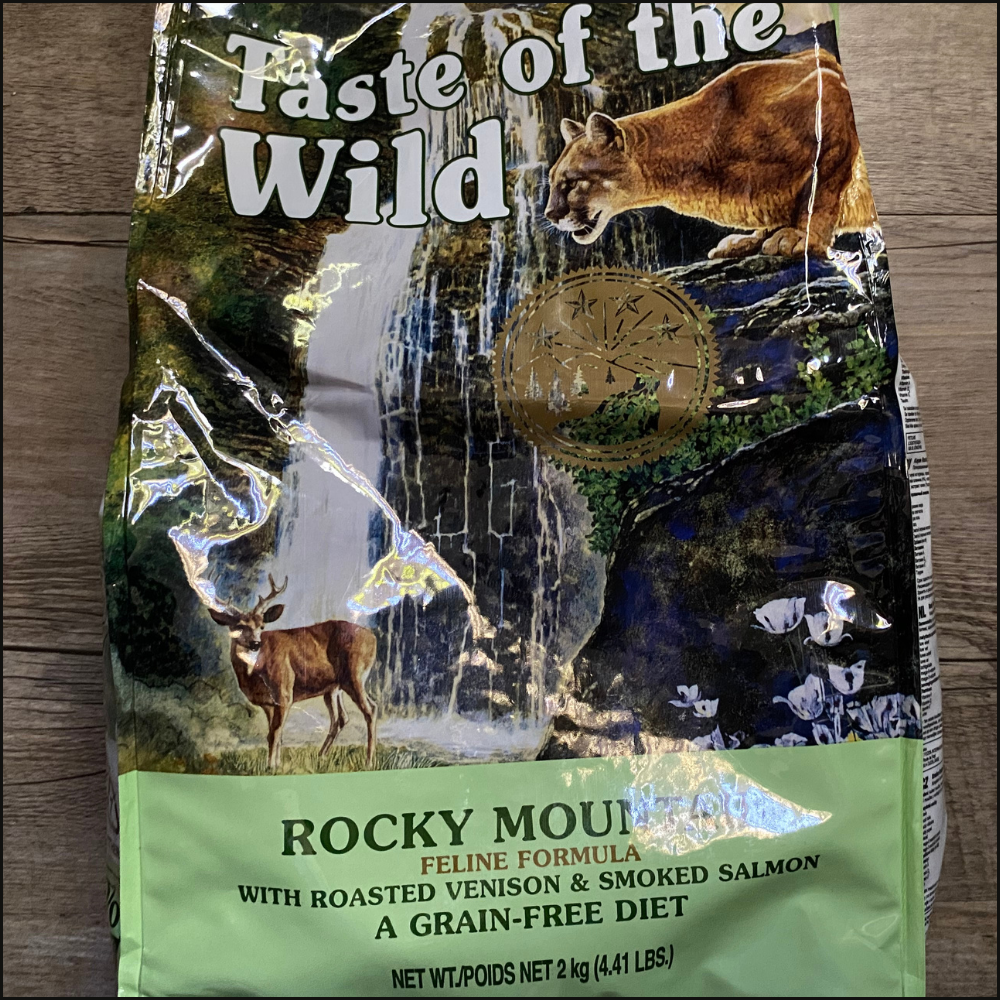
Pros
Cons
Taste of the Wild Ingredients
Chicken Meal, Peas, Sweet Potatoes, Chicken Fat (Preserved With Mixed Tocopherols), Pea Protein, Potato Protein, Roasted Venison, Smoke-Flavored Salmon, Natural Flavor, Ocean Fish Meal, Dl-Methionine, Potassium Chloride, Taurine, Choline Chloride, Dried Chicory Root, Tomatoes, Blueberries, Raspberries, Yucca Schidigera Extract, Dried Lactobacillus Plantarum Fermentation Product, Dried Bacillus Subtilis Fermentation Product, Dried Lactobacillus Acidophilus Fermentation Product, Dried Enterococcus Faecium Fermentation Product, Dried Bifidobacterium Animalis Fermentation Product, Zinc Proteinate, Vitamin E Supplement, Niacin, Manganese Proteinate, Copper Proteinate, Zinc Sulfate, Manganese Sulfate, Copper Sulfate, Thiamine Mononitrate, Vitamin A Supplement, Biotin, Potassium Iodide, Calcium Pantothenate, Riboflavin, Pyridoxine Hydrochloride, Vitamin B12 Supplement, Sodium Selenite, Vitamin D3 Supplement, Folic Acid
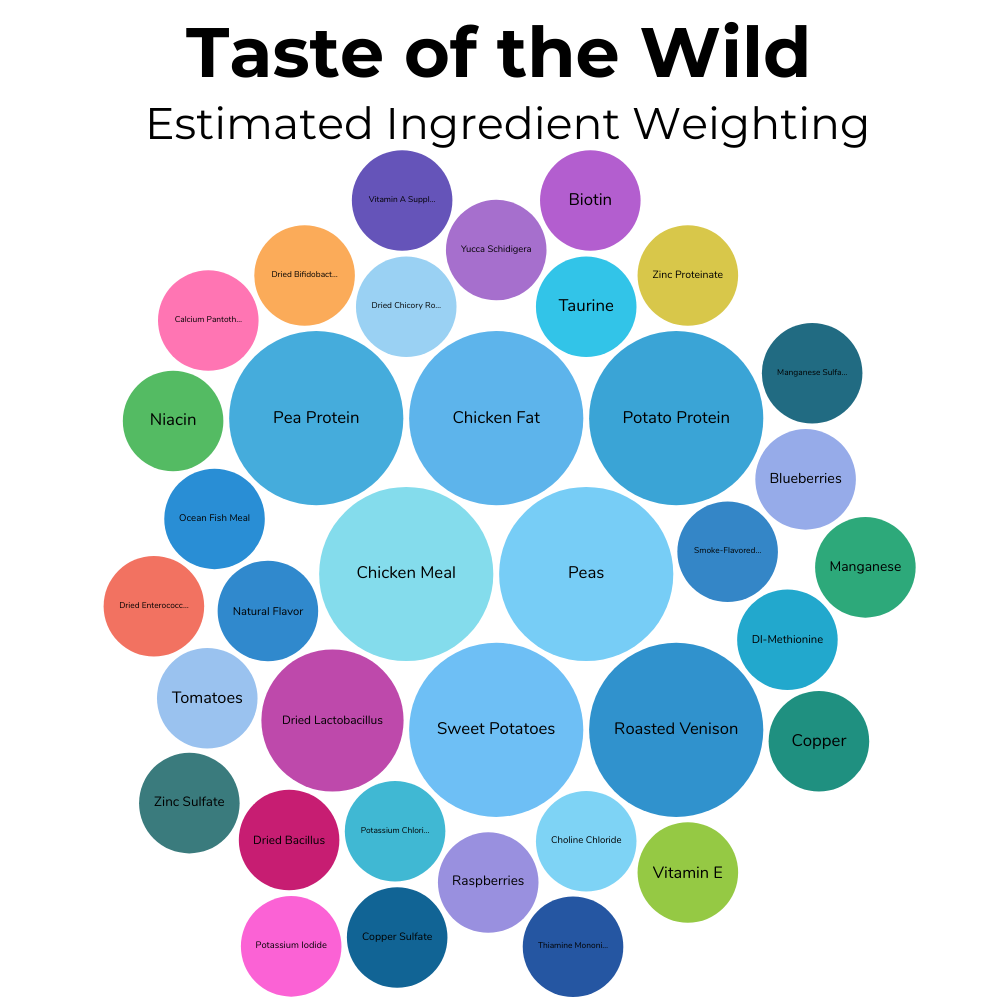
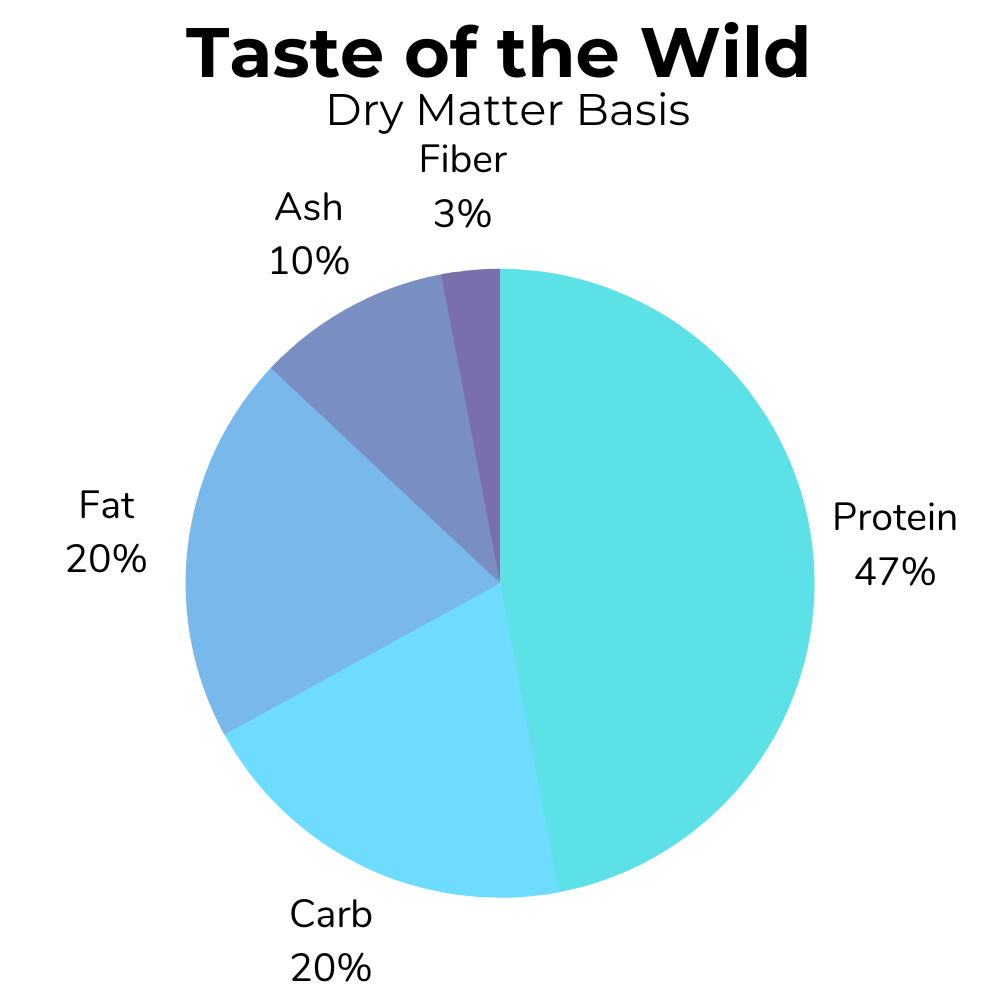
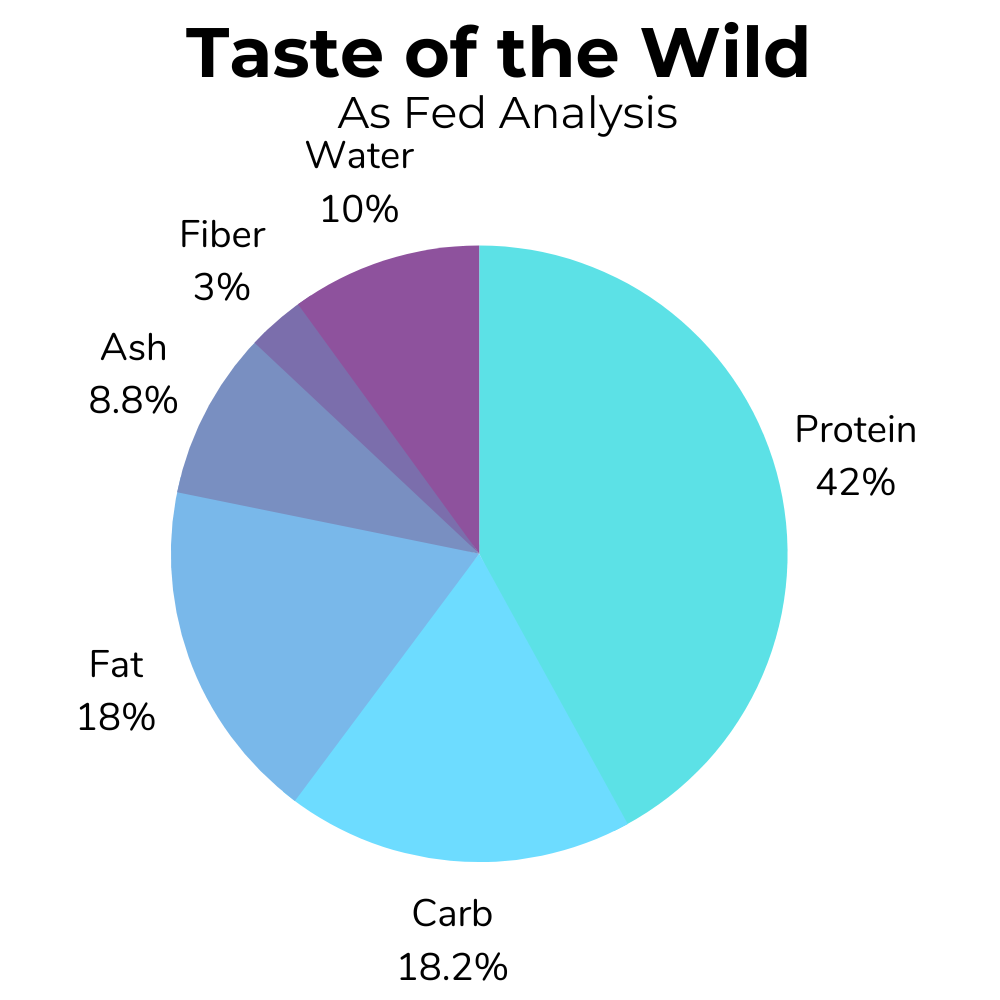
| Key Feature | Note |
|---|---|
| Type | Dry (kibble) |
| Lifestage | All |
| Energy (kcal/kg) | 3,745 |
| Made in | USA |
| Cost per ounce* (market ave) | $0.18 ($0.48) |
What Is Grain-Free Cat Food?
As the name suggests, grain-free cat food is free of grains.
Grains are the seeds of different types of grass. They’re harvested and processed into food used in pet foods.
Types of grains include:
- Wheat: One of the most widely consumed grains.
- Rice: Consumed as a staple in many cultures. Includes white, brown, jasmine, basmati, and wild rice.
- Barley: Used in food products, animal feed, and also in the production of beer and whiskey.
- Corn (Maize): Used in various food products, animal feed, and for making corn ethanol.
- Oats: Often as oatmeal or rolled oats.
- Rye: Used more often for rye bread, rye beer, and some whiskeys.
- Millet: Includes various small-seeded species like pearl millet, finger millet, and foxtail millet.
- Sorghum: Used as a grain, in syrups, and as fodder for livestock.
- Quinoa: Though technically a pseudocereal, it is often classed as a grain.
- Buckwheat: Another pseudocereal that is used similarly to grains in various dishes.
- Teff: A small grain native to Ethiopia and Eritrea.
- Spelt: An ancient grain related to wheat.
- Amaranth: Yet another pseudocereal that is rich in protein and other nutrients.
- Farro: An ancient wheat grain, also known as emmer.
- Bulgur: A whole grain made from cracked wheat.
- Kamut: A brand for an ancient variety of grain related to wheat, also known as Khorasan wheat.
A grain-free cat food should not contain any of those grains in its formulation.
Is Grain-Free Cat Food a Good Choice?
It’s not clear if grain-free is good for cats.
As carnivores, cats do not typically consume grains in the wild. All a cats nutrients are obtained from prey like rodents and insects.
AAFCO, a non-profit organisation who set nutrition guidelines for pets, do not have any recommendation for carbohydrate.
So from that point of view, there’s no need to have grains in the diet – but are they something to avoid? After all, they are affordable food sources (i.e. less cost to you)?
Grains are a high carbohydrate food. They don’t provide a high percent of protein, which is what cats need and prefer (cats prefer diets with fewer than 20g carbs/day).
The quality of grain protein is also poor.
Wheat gluten has a protein digestibility corrected amino acid score (PDCAAS) of 25% (compared to 100% for proteins like egg).
In basic terms, that means the protein isn’t well digested and doesn’t contain as many essential amino acids.
Some sources say carbs are great energy sources for cats, but cats use protein for energy as carnivores. Grains may also contain mycotoxin, which could intefere with healthy growth in kittens.
Grains are a food linked with food intolerance. This can cause vomiting and pruritis (itchy skin).
Do Grain-Free Diets Cause Heart Disease?
This hasn’t been shown as far as I’ve seen.
In 2020, there was a report of 1,100 dogs and 20 cats with dilated cardiomyopathy (DCM), an abnormal heart condition.
A sample of those dogs found up to 93% were eating grain-free diets. So this caused people to point the finger to avoiding grains as a critical nutrient.
However, nobody has a mechanism of action for why grains are a vital food that once removed, cause DCM.
We do know DCM is linked to taurine deficiency in dogs. In the 1980’s a taurine deficiency led to the deaths of thousands of cats being fed taurine deficient dry cat food.
Taurine is needed to regulate calcium balance in the heart, which helps it pump blood properly.
The nutrient taurine isn’t found in grains or plant items, it’s an essential amino acid rich in meats and fish. So removing grains should not be a problem here.
What could be a problem is the replacement food.
A diet high in oligosaccharides and soluble fiber may interfere with taurine absorption. Many grain-free foods replace grains with peas and legumes, which are high in oligosacchardies and soluble fiber.
Whether that’s the cause of the problem isn’t clear. It could be a combination of lack of proper taurine provision in cat food, lack of high taurine rich foods (e.g. meat and fish) and poor absorption of taurine.
Choosing Grain-Free Cat Food
Whether you choose grain-free cat food or not, it’s important to use complete cat food.
Check the statement of nutritional adequacy.
Look for either:
- Growth: For kittens up to 1 years
- Maintenance: Adults 1-7 years
- All life stages: Either
Got a 7 month old kitten? Choose growth or all life stages.
5 year old adult? Maintenance or all life stages.
Seniors are a tricky one. I recommend reading my guide below for help with older cats.
Also consider my other guides for specific topics or continue on.
Related:
Frequently Asked Questions
Conclusion
Cats are carnivores and don’t need to eat grains.
Whilst cats can digest starch rich foods like grains, these foods offer little nutrition. Some cats may have allergies or food intolerances related to grains.
Regardless of what you go with, always choose cat food that offers complete nutrition (meeting the nutrition guidelines set by AAFCO).
>> My top grain-free cat food pick is Fussie Cat Premium


